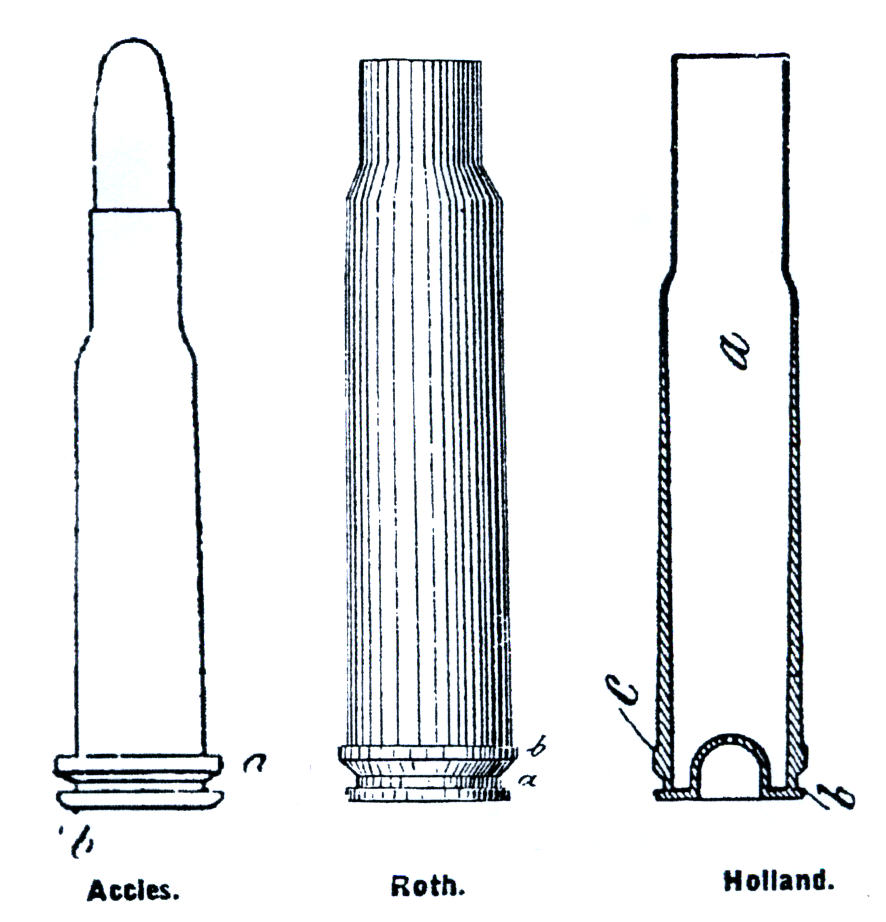First appeared around 1905. Chronologically this was the first of the series. This cartridge was unique in that it was the first to use a belt for headspacing rather than a rim or using the shoulder. Ballistics for the .400/375 were identical to the 9,5 Mannticher Schoenauer, with which it was designed to compete viz. a 270 grain bullet at 2150 fps. At this stage the 9.5 Mannlicher was the leader in a race for a large medium bore, suitable for general African and Asian hunting. The Mannlicher rifles are delightful little carbines and the calibre quickly took off. The British gun trade adopted the 9,5 M-S as the .375 Rimless Nitro Express. (see 9.5 x 57 Mannlicher – and the discussion that it might in all probability have been a British development and not German). The belted design of the Holland & Holland certainly eased manufacturing procedure since it was nearly as easy to produce the correct headspace with a belt as with a rim, and yet didn’t give the feeding trouble/complicated magazine design of a rimmed case. Reloading was out of vogue in the British world and reliability of function was the key, even above accuracy. At the same time Mauser introduced their rifles chambered for the 9.3×62 cartridge designed by Mr. BOCK of Berlin. The 9.3 possessed more than adequate penetration and the first cartridge that could be considered an all rounder. This 9.3×62 cartridge soon proved to be better than the 9.5 MS and the .400/.375 H&H and so the Holland cartridge faded very quickly.







 This last specimen is a vanity headstamp for a South African hunter with the serial number of his rifle on the headstamp.
This last specimen is a vanity headstamp for a South African hunter with the serial number of his rifle on the headstamp.







The History of Belted Cartridges
The reason for the appearance of the belted case is easily overlooked today with modern machining procedures and better chamber reamers. In the early days of metalic cartridges headspacing could be a problem. Precision machining had to be done by hand, and chamber reamers were soft and wore out quickly. Rimmed or belted cases were much simpler. In addition the chamber of a rimmed or belted case could be made oversize, which was a considerable aid to extraction from a hot or dirty rifle. If the cartridge did not have a belt or a rim the cartridge could slip into the chamber too far and cause misfires as the firing pin failed to reach the primer with sufficient force.
The first cartridges with belts were probably the .41 Roper, dating from about 1866. Patents on the idea were taken out by Mr. J.G. Accles of Birmingham in 1889 as a ‘double flanged’ cartridge. His patent stated that one flange was to prevent the cartridge going too far into the chamber and by having a second flange for extraction the barrel chamber did not have to be cut away to allow an extractor to grab the case, it simply used the second flange. G. Roth of Vienna also took out a patent for a “collar” to accurately limit the depth to which the cartridge could be inserted into the breech chamber. This patent was granted in 1892.
Mr. H.W. Holland applied for a patent for a cartridge case to have a ‘small ridge’ in front of the extractor groove. This patent was granted in 1905 and marked the beginning of a vast array of belted cartridge cases. The Holland case was the first to be successfully launched to the shooting public.

